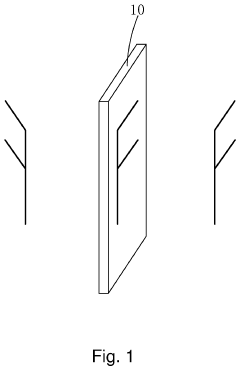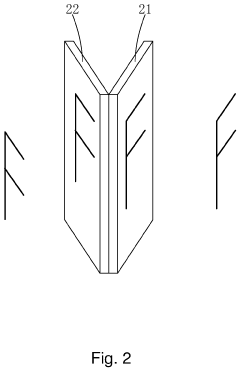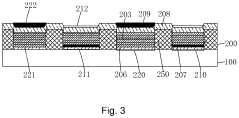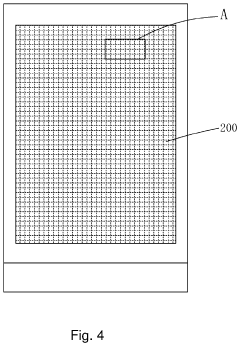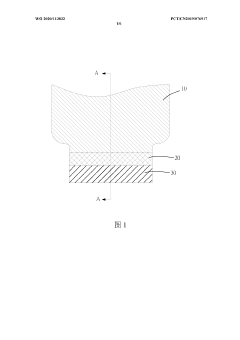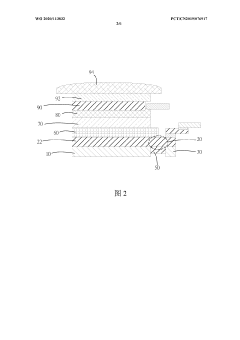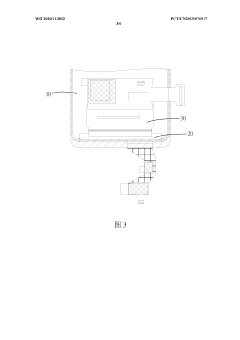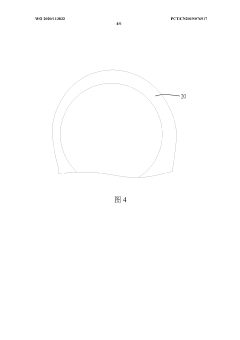Public perception of flexible AMOLED tech in daily use.
JUL 17, 20258 MIN READ
Generate Your Research Report Instantly with AI Agent
Patsnap Eureka helps you evaluate technical feasibility & market potential.
AMOLED Evolution and Objectives
The evolution of AMOLED (Active-Matrix Organic Light-Emitting Diode) technology has been a significant milestone in display innovation, particularly in its flexible form. This technological advancement has revolutionized the way we interact with electronic devices, offering new possibilities for product design and user experience.
AMOLED technology emerged in the early 2000s as an improvement over traditional LCD displays, offering better color reproduction, higher contrast ratios, and lower power consumption. The development of flexible AMOLED displays began in the mid-2000s, with companies like Samsung and LG leading the charge in research and development.
The primary objective of flexible AMOLED technology is to create displays that can be bent, folded, or rolled without compromising image quality or functionality. This goal aligns with the broader trend of creating more versatile and adaptable electronic devices that can seamlessly integrate into various aspects of daily life.
In recent years, the focus has shifted towards enhancing the durability and reliability of flexible AMOLED displays for everyday use. Manufacturers aim to develop screens that can withstand repeated bending and folding without degradation in performance or visual quality. This objective is crucial for the widespread adoption of flexible display technology in consumer electronics.
Another key goal is to improve the energy efficiency of flexible AMOLED displays. As mobile devices continue to play an increasingly important role in our lives, extending battery life through more efficient display technology becomes paramount. Researchers are exploring new materials and manufacturing processes to achieve this objective.
The evolution of flexible AMOLED technology also aims to expand its applications beyond smartphones and wearables. There is growing interest in incorporating flexible displays into automotive interiors, smart home devices, and even clothing. This diversification of use cases presents both opportunities and challenges for researchers and manufacturers.
As the technology progresses, there is a strong focus on enhancing the user experience through improved touch sensitivity, better outdoor visibility, and reduced blue light emission. These objectives are driven by the increasing amount of time people spend interacting with screens and the growing awareness of the potential health impacts of prolonged device use.
In conclusion, the evolution of flexible AMOLED technology is driven by the objectives of creating more versatile, durable, energy-efficient, and user-friendly displays. The ultimate goal is to seamlessly integrate this technology into various aspects of daily life, transforming the way we interact with information and our environment.
AMOLED technology emerged in the early 2000s as an improvement over traditional LCD displays, offering better color reproduction, higher contrast ratios, and lower power consumption. The development of flexible AMOLED displays began in the mid-2000s, with companies like Samsung and LG leading the charge in research and development.
The primary objective of flexible AMOLED technology is to create displays that can be bent, folded, or rolled without compromising image quality or functionality. This goal aligns with the broader trend of creating more versatile and adaptable electronic devices that can seamlessly integrate into various aspects of daily life.
In recent years, the focus has shifted towards enhancing the durability and reliability of flexible AMOLED displays for everyday use. Manufacturers aim to develop screens that can withstand repeated bending and folding without degradation in performance or visual quality. This objective is crucial for the widespread adoption of flexible display technology in consumer electronics.
Another key goal is to improve the energy efficiency of flexible AMOLED displays. As mobile devices continue to play an increasingly important role in our lives, extending battery life through more efficient display technology becomes paramount. Researchers are exploring new materials and manufacturing processes to achieve this objective.
The evolution of flexible AMOLED technology also aims to expand its applications beyond smartphones and wearables. There is growing interest in incorporating flexible displays into automotive interiors, smart home devices, and even clothing. This diversification of use cases presents both opportunities and challenges for researchers and manufacturers.
As the technology progresses, there is a strong focus on enhancing the user experience through improved touch sensitivity, better outdoor visibility, and reduced blue light emission. These objectives are driven by the increasing amount of time people spend interacting with screens and the growing awareness of the potential health impacts of prolonged device use.
In conclusion, the evolution of flexible AMOLED technology is driven by the objectives of creating more versatile, durable, energy-efficient, and user-friendly displays. The ultimate goal is to seamlessly integrate this technology into various aspects of daily life, transforming the way we interact with information and our environment.
Flexible Display Market Analysis
The flexible display market has been experiencing significant growth in recent years, driven by the increasing adoption of flexible AMOLED technology in consumer electronics. This market segment is characterized by its potential to revolutionize device form factors and user experiences, particularly in smartphones, wearables, and automotive applications.
Consumer perception of flexible AMOLED technology in daily use has been largely positive, with users appreciating the enhanced durability, lighter weight, and innovative design possibilities offered by these displays. The ability to create curved, foldable, and rollable devices has captured the imagination of consumers, leading to a growing demand for products incorporating this technology.
Market analysis indicates that the flexible display market is expected to continue its upward trajectory, with a compound annual growth rate (CAGR) projected to remain in double digits over the next five years. This growth is fueled by advancements in manufacturing processes, increased production capacity, and declining costs, making flexible displays more accessible to a wider range of device manufacturers.
The smartphone segment currently dominates the flexible display market, with major players like Samsung and Huawei leading the charge in foldable device offerings. However, the market is diversifying rapidly, with emerging applications in smartwatches, tablets, and automotive displays gaining traction. This expansion into new product categories is expected to further drive market growth and consumer adoption.
Geographically, Asia-Pacific remains the largest market for flexible displays, owing to the presence of key manufacturers and a strong consumer electronics industry. North America and Europe are also significant markets, with increasing demand for premium devices featuring flexible displays.
Despite the positive market outlook, challenges remain in terms of production costs, yield rates, and long-term durability of flexible displays. Manufacturers are investing heavily in research and development to address these issues and improve the overall performance and lifespan of flexible AMOLED technology.
Consumer education and hands-on experience with flexible display devices are crucial factors influencing public perception and adoption rates. As more products enter the market and users become familiar with the benefits of flexible displays, the technology is expected to gain wider acceptance and become a standard feature in various consumer electronics.
Consumer perception of flexible AMOLED technology in daily use has been largely positive, with users appreciating the enhanced durability, lighter weight, and innovative design possibilities offered by these displays. The ability to create curved, foldable, and rollable devices has captured the imagination of consumers, leading to a growing demand for products incorporating this technology.
Market analysis indicates that the flexible display market is expected to continue its upward trajectory, with a compound annual growth rate (CAGR) projected to remain in double digits over the next five years. This growth is fueled by advancements in manufacturing processes, increased production capacity, and declining costs, making flexible displays more accessible to a wider range of device manufacturers.
The smartphone segment currently dominates the flexible display market, with major players like Samsung and Huawei leading the charge in foldable device offerings. However, the market is diversifying rapidly, with emerging applications in smartwatches, tablets, and automotive displays gaining traction. This expansion into new product categories is expected to further drive market growth and consumer adoption.
Geographically, Asia-Pacific remains the largest market for flexible displays, owing to the presence of key manufacturers and a strong consumer electronics industry. North America and Europe are also significant markets, with increasing demand for premium devices featuring flexible displays.
Despite the positive market outlook, challenges remain in terms of production costs, yield rates, and long-term durability of flexible displays. Manufacturers are investing heavily in research and development to address these issues and improve the overall performance and lifespan of flexible AMOLED technology.
Consumer education and hands-on experience with flexible display devices are crucial factors influencing public perception and adoption rates. As more products enter the market and users become familiar with the benefits of flexible displays, the technology is expected to gain wider acceptance and become a standard feature in various consumer electronics.
Flexible AMOLED Challenges
Flexible AMOLED technology, while promising, faces several significant challenges in its journey towards widespread adoption and public acceptance. One of the primary hurdles is the durability and longevity of flexible displays. Users are accustomed to the robustness of traditional glass screens, and there are concerns about the resilience of flexible displays to repeated bending, folding, and everyday wear and tear. This perception of fragility could deter potential consumers from embracing the technology.
Another challenge lies in the manufacturing process and associated costs. The production of flexible AMOLED displays is complex and expensive, which translates to higher prices for end consumers. This cost barrier may limit the technology's accessibility to a broader market, potentially slowing its adoption rate and public acceptance.
The visual quality and performance of flexible displays also present challenges. While AMOLED technology offers vibrant colors and deep blacks, maintaining consistent image quality across a bent or folded screen is technically demanding. Issues such as color shift, brightness uniformity, and potential creasing at fold points can affect the user experience and public perception of the technology's readiness for daily use.
Power consumption is another area of concern. Flexible AMOLED displays, particularly in foldable devices, often require larger batteries to power larger screen areas. This can lead to trade-offs in device thickness and weight, potentially impacting the sleek, lightweight design that consumers expect from modern mobile devices.
The integration of touch functionality with flexible displays poses additional challenges. Ensuring accurate and responsive touch input across curved or folded surfaces requires sophisticated engineering solutions. Any perceived lag or inaccuracy in touch response could significantly impact user satisfaction and trust in the technology.
Lastly, the novelty of flexible AMOLED technology itself presents a challenge in terms of user adaptation. The public may need time to adjust to new form factors and usage paradigms enabled by flexible displays. This includes learning new gestures, adapting to different device configurations, and finding practical applications for the technology in their daily lives.
Overcoming these challenges is crucial for the widespread acceptance and integration of flexible AMOLED technology into everyday devices. As the technology matures and these issues are addressed, public perception is likely to evolve, potentially leading to greater adoption and innovative applications in various sectors beyond mobile devices.
Another challenge lies in the manufacturing process and associated costs. The production of flexible AMOLED displays is complex and expensive, which translates to higher prices for end consumers. This cost barrier may limit the technology's accessibility to a broader market, potentially slowing its adoption rate and public acceptance.
The visual quality and performance of flexible displays also present challenges. While AMOLED technology offers vibrant colors and deep blacks, maintaining consistent image quality across a bent or folded screen is technically demanding. Issues such as color shift, brightness uniformity, and potential creasing at fold points can affect the user experience and public perception of the technology's readiness for daily use.
Power consumption is another area of concern. Flexible AMOLED displays, particularly in foldable devices, often require larger batteries to power larger screen areas. This can lead to trade-offs in device thickness and weight, potentially impacting the sleek, lightweight design that consumers expect from modern mobile devices.
The integration of touch functionality with flexible displays poses additional challenges. Ensuring accurate and responsive touch input across curved or folded surfaces requires sophisticated engineering solutions. Any perceived lag or inaccuracy in touch response could significantly impact user satisfaction and trust in the technology.
Lastly, the novelty of flexible AMOLED technology itself presents a challenge in terms of user adaptation. The public may need time to adjust to new form factors and usage paradigms enabled by flexible displays. This includes learning new gestures, adapting to different device configurations, and finding practical applications for the technology in their daily lives.
Overcoming these challenges is crucial for the widespread acceptance and integration of flexible AMOLED technology into everyday devices. As the technology matures and these issues are addressed, public perception is likely to evolve, potentially leading to greater adoption and innovative applications in various sectors beyond mobile devices.
Current Flexible AMOLED Solutions
01 Display technology advancements
Flexible AMOLED technology represents a significant advancement in display technology, offering improved visual quality, energy efficiency, and form factor flexibility. This innovation has garnered positive public perception due to its potential applications in various consumer electronics, particularly smartphones and wearable devices.- Display technology advancements: Flexible AMOLED technology has led to significant advancements in display technology, enabling the creation of bendable and foldable screens. This innovation has captured public interest due to its potential applications in smartphones, wearables, and other consumer electronics. The technology offers improved visual quality, energy efficiency, and durability compared to traditional displays.
- Consumer perception and adoption: Public perception of flexible AMOLED technology has been generally positive, with consumers showing interest in the novel form factors and enhanced user experiences it enables. However, concerns about durability, cost, and practical applications have influenced adoption rates. Market research and consumer surveys have been conducted to gauge public opinion and inform product development strategies.
- Manufacturing challenges and innovations: The production of flexible AMOLED displays presents unique manufacturing challenges, which have been a focus of industry innovation. Advancements in materials science, fabrication techniques, and quality control processes have been necessary to overcome these challenges and improve yield rates. Public awareness of these manufacturing complexities has influenced perceptions of product value and pricing.
- Integration in various devices: Flexible AMOLED technology has been integrated into a wide range of devices beyond smartphones, including smartwatches, automotive displays, and home appliances. This versatility has expanded public interest and acceptance of the technology across different sectors. The ability to create curved and uniquely shaped displays has opened up new design possibilities and use cases.
- Environmental and sustainability considerations: Public perception of flexible AMOLED technology has been influenced by environmental and sustainability concerns. The potential for reduced material waste due to the technology's durability and the possibility of creating more energy-efficient devices have been viewed positively. However, questions about the recyclability and long-term environmental impact of these displays have also been raised, affecting public opinion and industry practices.
02 Consumer acceptance and market trends
The public perception of flexible AMOLED technology has been largely positive, with consumers showing interest in devices featuring these displays. Market trends indicate a growing demand for products incorporating flexible AMOLED screens, driven by the technology's ability to enable novel form factors and enhance user experience.Expand Specific Solutions03 Durability and reliability concerns
While flexible AMOLED technology has generated excitement, there are public concerns regarding the durability and long-term reliability of these displays. Manufacturers are addressing these issues through ongoing research and development efforts to improve the robustness of flexible AMOLED panels.Expand Specific Solutions04 Integration with other technologies
The public perception of flexible AMOLED technology is influenced by its potential integration with other emerging technologies, such as touch sensors, biometric systems, and foldable device mechanisms. This convergence of technologies is seen as a driver for innovation in the consumer electronics industry.Expand Specific Solutions05 Environmental and sustainability aspects
Public perception of flexible AMOLED technology also considers its environmental impact and sustainability. The potential for reduced material usage and energy consumption in manufacturing and operation of these displays contributes to a positive perception among environmentally conscious consumers.Expand Specific Solutions
Flexible Display Industry Leaders
The flexible AMOLED technology market is in a growth phase, with increasing public awareness and adoption in daily use devices. The global market size for flexible AMOLED displays is expanding rapidly, driven by demand for smartphones, wearables, and other consumer electronics. Technologically, flexible AMOLED is maturing, with key players like Samsung Electronics, LG Electronics, and BOE Technology Group leading innovation. Chinese companies such as Visionox and Tianma Microelectronics are also making significant strides, narrowing the gap with established market leaders. The technology's maturity is evident in improved production yields, enhanced display quality, and increased durability of flexible panels.
BOE Technology Group Co., Ltd.
Technical Solution: BOE has been at the forefront of flexible AMOLED technology development, focusing on improving public perception through enhanced display quality and durability. Their latest flexible AMOLED panels feature a 1.5R bending radius[1], allowing for more versatile device designs. BOE has also implemented advanced pixel compensation technology to address image retention issues, a common concern in OLED displays[2]. To improve durability, they've developed a proprietary encapsulation technique that significantly reduces moisture and oxygen penetration, extending the lifespan of flexible displays in daily use[3]. BOE's panels now achieve a color gamut coverage of over 100% DCI-P3[4], addressing concerns about color accuracy and vibrancy in flexible displays.
Strengths: Advanced bending capabilities, improved durability, and high color accuracy. Weaknesses: Higher production costs compared to traditional displays, potential for burn-in over extended use.
Huawei Technologies Co., Ltd.
Technical Solution: Huawei has been investing heavily in flexible AMOLED technology to improve public perception and user experience. Their latest foldable devices feature an anti-reflection nano-optical layer that reduces glare by up to 56%, addressing visibility concerns in bright environments[13]. Huawei has also developed a multi-layer cooling system for flexible displays, effectively dissipating heat and maintaining consistent performance during extended use[14]. To address durability concerns, they've implemented a new hinge design that reduces stress on the flexible display when folding and unfolding[15]. Huawei's AI-powered display engine optimizes color and contrast in real-time, ensuring consistent image quality across the curved surface of flexible displays[16].
Strengths: Advanced anti-reflection technology, efficient thermal management, and AI-enhanced display quality. Weaknesses: Limited global market access due to trade restrictions, potential supply chain challenges for key components.
Key Flexible AMOLED Innovations
Amoled double-side display
PatentActiveUS20200219957A1
Innovation
- An AMOLED double-sided display design featuring a substrate with alternating top-emitting and bottom-emitting OLED units, where the anode of top-emitting units is thicker and reflective, and the cathode of bottom-emitting units is thicker and light-transmissive, allowing for single IC control and eliminating mirrored images.
Active matrix organic light-emitting diode panel
PatentWO2020113832A1
Innovation
- A water glue layer is set on the bent part of the AMOLED panel, and is shaped by UV curing. Combined with an insulating base material layer made of polyimide material, the area of the second backplane is smaller than the first backplane, ensuring that the water glue layer is The layers provide structural strength and toughness when bent.
Consumer Adoption Factors
The adoption of flexible AMOLED technology in daily use is influenced by several key consumer factors. Primarily, the perceived value proposition plays a crucial role in shaping public perception. Consumers are increasingly drawn to the unique features offered by flexible displays, such as enhanced durability, improved portability, and innovative form factors. These attributes align with the growing demand for more versatile and resilient devices in everyday life.
User experience is another critical factor driving consumer adoption. The tactile sensation and visual appeal of flexible AMOLED screens contribute significantly to the overall user satisfaction. As consumers become more accustomed to interacting with bendable displays, their comfort level and appreciation for the technology tend to increase. This familiarity often leads to a positive feedback loop, further accelerating adoption rates.
Price sensitivity remains a considerable factor in the public's perception and adoption of flexible AMOLED technology. Initially, the higher cost associated with this advanced display technology posed a barrier to widespread adoption. However, as manufacturing processes have improved and economies of scale have been achieved, the price gap between flexible and traditional displays has narrowed, making flexible AMOLED devices more accessible to a broader consumer base.
The perceived reliability and longevity of flexible AMOLED technology also significantly influence consumer adoption. Early concerns about the durability of bendable screens have been gradually addressed through technological advancements and real-world performance data. As consumers gain confidence in the long-term reliability of flexible displays, their willingness to invest in devices featuring this technology increases.
Brand reputation and marketing strategies play a substantial role in shaping public perception. Established technology brands that have successfully integrated flexible AMOLED displays into their product lines have helped legitimize the technology in the eyes of consumers. Effective marketing campaigns highlighting the unique benefits and use cases of flexible displays have further contributed to positive public perception and increased adoption rates.
Lastly, the availability of compelling applications and content optimized for flexible displays significantly impacts consumer adoption. As developers create innovative software experiences that leverage the unique properties of flexible AMOLED screens, consumers are more likely to see tangible benefits in their daily use, driving both interest and adoption of the technology.
User experience is another critical factor driving consumer adoption. The tactile sensation and visual appeal of flexible AMOLED screens contribute significantly to the overall user satisfaction. As consumers become more accustomed to interacting with bendable displays, their comfort level and appreciation for the technology tend to increase. This familiarity often leads to a positive feedback loop, further accelerating adoption rates.
Price sensitivity remains a considerable factor in the public's perception and adoption of flexible AMOLED technology. Initially, the higher cost associated with this advanced display technology posed a barrier to widespread adoption. However, as manufacturing processes have improved and economies of scale have been achieved, the price gap between flexible and traditional displays has narrowed, making flexible AMOLED devices more accessible to a broader consumer base.
The perceived reliability and longevity of flexible AMOLED technology also significantly influence consumer adoption. Early concerns about the durability of bendable screens have been gradually addressed through technological advancements and real-world performance data. As consumers gain confidence in the long-term reliability of flexible displays, their willingness to invest in devices featuring this technology increases.
Brand reputation and marketing strategies play a substantial role in shaping public perception. Established technology brands that have successfully integrated flexible AMOLED displays into their product lines have helped legitimize the technology in the eyes of consumers. Effective marketing campaigns highlighting the unique benefits and use cases of flexible displays have further contributed to positive public perception and increased adoption rates.
Lastly, the availability of compelling applications and content optimized for flexible displays significantly impacts consumer adoption. As developers create innovative software experiences that leverage the unique properties of flexible AMOLED screens, consumers are more likely to see tangible benefits in their daily use, driving both interest and adoption of the technology.
Sustainability in AMOLED Production
Sustainability in AMOLED production has become a critical focus as the technology gains widespread adoption in consumer electronics. The manufacturing process of flexible AMOLED displays involves complex procedures and materials that can have significant environmental impacts if not managed properly.
One of the primary sustainability challenges in AMOLED production is the use of rare earth elements and precious metals. These materials are essential for creating the vibrant colors and high contrast ratios that AMOLED displays are known for. However, their extraction and processing can lead to environmental degradation and resource depletion. To address this, manufacturers are investing in research to develop alternative materials and more efficient extraction methods.
Energy consumption during the production process is another major concern. The fabrication of AMOLED displays requires precise temperature control and clean room environments, which are energy-intensive. Industry leaders are implementing energy-efficient manufacturing practices and exploring the use of renewable energy sources to power their production facilities. This not only reduces the carbon footprint but also helps in managing long-term operational costs.
Water usage and waste management are also key sustainability issues in AMOLED production. The manufacturing process involves multiple cleaning and etching steps that consume significant amounts of water and generate potentially hazardous waste. Companies are developing closed-loop water systems and advanced waste treatment technologies to minimize environmental impact and comply with increasingly stringent regulations.
The lifespan and recyclability of AMOLED displays play a crucial role in their overall sustainability. As flexible AMOLED technology becomes more prevalent in daily use, there is a growing emphasis on designing products for longevity and ease of recycling. Manufacturers are working on improving the durability of flexible displays and developing modular designs that facilitate repair and component replacement, thus extending the lifecycle of devices.
Public perception of the sustainability of AMOLED technology is influencing consumer behavior and corporate strategies. As awareness of environmental issues grows, consumers are increasingly considering the ecological footprint of their electronic devices. This has prompted manufacturers to not only improve their production processes but also to communicate their sustainability efforts more transparently to the public.
In response to these challenges and public concerns, the AMOLED industry is collaborating on sustainability initiatives. Industry consortiums are establishing best practices for sustainable production, sharing research on eco-friendly materials, and working towards standardized sustainability metrics for display technologies. These collaborative efforts aim to drive innovation in sustainable manufacturing while meeting the growing demand for flexible AMOLED displays in various applications.
One of the primary sustainability challenges in AMOLED production is the use of rare earth elements and precious metals. These materials are essential for creating the vibrant colors and high contrast ratios that AMOLED displays are known for. However, their extraction and processing can lead to environmental degradation and resource depletion. To address this, manufacturers are investing in research to develop alternative materials and more efficient extraction methods.
Energy consumption during the production process is another major concern. The fabrication of AMOLED displays requires precise temperature control and clean room environments, which are energy-intensive. Industry leaders are implementing energy-efficient manufacturing practices and exploring the use of renewable energy sources to power their production facilities. This not only reduces the carbon footprint but also helps in managing long-term operational costs.
Water usage and waste management are also key sustainability issues in AMOLED production. The manufacturing process involves multiple cleaning and etching steps that consume significant amounts of water and generate potentially hazardous waste. Companies are developing closed-loop water systems and advanced waste treatment technologies to minimize environmental impact and comply with increasingly stringent regulations.
The lifespan and recyclability of AMOLED displays play a crucial role in their overall sustainability. As flexible AMOLED technology becomes more prevalent in daily use, there is a growing emphasis on designing products for longevity and ease of recycling. Manufacturers are working on improving the durability of flexible displays and developing modular designs that facilitate repair and component replacement, thus extending the lifecycle of devices.
Public perception of the sustainability of AMOLED technology is influencing consumer behavior and corporate strategies. As awareness of environmental issues grows, consumers are increasingly considering the ecological footprint of their electronic devices. This has prompted manufacturers to not only improve their production processes but also to communicate their sustainability efforts more transparently to the public.
In response to these challenges and public concerns, the AMOLED industry is collaborating on sustainability initiatives. Industry consortiums are establishing best practices for sustainable production, sharing research on eco-friendly materials, and working towards standardized sustainability metrics for display technologies. These collaborative efforts aim to drive innovation in sustainable manufacturing while meeting the growing demand for flexible AMOLED displays in various applications.
Unlock deeper insights with Patsnap Eureka Quick Research — get a full tech report to explore trends and direct your research. Try now!
Generate Your Research Report Instantly with AI Agent
Supercharge your innovation with Patsnap Eureka AI Agent Platform!
